Instructor’s
Instructor’s
Manual
Manual
�
NOTICE
This manual is intended for your personal use only.
Copying, printing, posting, or any form of printed or electronic
distribution of any part of this manual constitutes a violation of
copyright law.
As a security measure, this manual was encrypted during download
with the serial number of your book, and with your personal information.
Any printed or electronic copies of this file will bear that encryption,
which will tie the copy to you.
Please help us defeat piracy of intellectual property, one of the principal
reasons for the increase in the cost of books.
-------------------------------
�
Digital Image Processing
Third Edition
Instructor's Manual
Version 3.0
Rafael C. Gonzalez
Richard E. Woods
Prentice Hall
Upper Saddle River, NJ 07458
www.imageprocessingplace.com
Copyright © 1992-2008 R. C. Gonzalez and R. E. Woods
�
NOTICE
This manual is intended for your personal use only.
Copying, printing, posting, or any form of printed or electronic
distribution of any part of this manual constitutes a violation of
copyright law.
As a security measure, this manual was encrypted during download
with the serial number of your book, and with your personal information.
Any printed or electronic copies of this file will bear that encryption,
which will tie the copy to you.
Please help us defeat piracy of intellectual property, one of the principal
reasons for the increase in the cost of books.
-------------------------------
�
Chapter 1
Introduction
The purpose of this chapter is to present suggested guidelines for teaching mate-
rial from Digital Image Processing at the senior and first-year graduate levels. We
also discuss use of the book web site. Although the book is totally self-contained,
the web site offers, among other things, complementary review material and
computer projects that can be assigned in conjunction with classroom work.
Detailed solutions to all problems in the book also are included in the remain-
ing chapters of this manual.
1.1 Teaching Features of the Book
Undergraduate programs that offer digital image processing typically limit cov-
erage to one semester. Graduate programs vary, and can include one or two
semesters of the material. In the following discussion we give general guidelines
for a one-semester senior course, a one-semester graduate course, and a full-
year course of study covering two semesters. We assume a 15-week program per
semester with three lectures per week. In order to provide flexibility for exams
and review sessions, the guidelines discussed in the following sections are based
on forty, 50-minute lectures per semester. The background assumed on the part
of the student is senior-level preparation in mathematical analysis, matrix the-
ory, probability, and computer programming. The Tutorials section in the book
web site contains review materials on matrix theory and probability, and has a
brief introduction to linear systems. PowerPoint classroom presentation mate-
rial on the review topics is available in the Faculty section of the web site.
The suggested teaching guidelines are presented in terms of general objec-
tives, and not as time schedules. There is so much variety in the way image pro-
cessing material is taught that it makes little sense to attempt a breakdown of the
material by class period. In particular, the organization of the present edition of
1
�
2
CHAPTER1. INTRODUCTION
the book is such that it makes it much easier than before to adopt significantly
different teaching strategies, depending on course objectives and student back-
ground. For example, it is possible with the new organization to offer a course
that emphasizes spatial techniques and covers little or no transform material.
This is not something we recommend, but it is an option that often is attractive
in programs that place little emphasis on the signal processing aspects of the
field and prefer to focus more on the implementation of spatial techniques.
1.2 One Semester Senior Course
A basic strategy in teaching a senior course is to focus on aspects of image pro-
cessing in which both the inputs and outputs of those processes are images.
In the scope of a senior course, this usually means the material contained in
Chapters 1 through 6. Depending on instructor preferences, wavelets (Chap-
ter 7) usually are beyond the scope of coverage in a typical senior curriculum.
However, we recommend covering at least some material on image compres-
sion (Chapter 8) as outlined below.
We have found in more than three decades of teaching this material to se-
niors in electrical engineering, computer science, and other technical disciplines,
that one of the keys to success is to spend at least one lecture on motivation
and the equivalent of one lecture on review of background material, as the need
arises. The motivational material is provided in the numerous application areas
dis1.2 One Semester Senior Coursecussed in Chapter 1. This chapter was pre-
pared with this objective in mind. Some of this material can be covered in class
in the first period and the rest assigned as independent reading. Background re-
view should cover probability theory (of one random variable) before histogram
processing (Section 3.3). A brief review of vectors and matrices may be required
later, depending on the material covered. The review material in the book web
site was designed for just this purpose.
Chapter 2 should be covered in its entirety. Some of the material (Sections
2.1 through 2.3.3) can be assigned as independent reading, but more detailed
explanation (combined with some additional independent reading) of Sections
2.3.4 and 2.4 through 2.6 is time well spent. The material in Section 2.6 covers
concepts that are used throughout the book and provides a number of image
processing applications that are useful as motivational background for the rest
of the book
Chapter 3 covers spatial intensity transformations and spatial correlation and
convolution as the foundation of spatial filtering. The chapter also covers a
number of different uses of spatial transformations and spatial filtering for im-
age enhancement. These techniques are illustrated in the context enhancement
�
1.2. ONESEMESTERSENIORCOURSE
3
(as motivational aids), but it is pointed out several times in the chapter that
the methods developed have a much broader range of application. For a se-
nior course, we recommend covering Sections 3.1 through 3.3.1, and Sections
3.4 through 3.6. Section 3.7 can be assigned as independent reading, depending
on time.
The key objectives of Chapter 4 are (1) to start from basic principles of signal
sampling and from these derive the discrete Fourier transform; and (2) to illus-
trate the use of filtering in the frequency domain. As in Chapter 3, we use mostly
examples from image enhancement, but make it clear that the Fourier trans-
form has a much broader scope of application. The early part of the chapter
through Section 4.2.2 can be assigned as independent reading. We recommend
careful coverage of Sections 4.2.3 through 4.3.4. Section 4.3.5 can be assigned as
independent reading. Section 4.4 should be covered in detail. The early part
of Section 4.5 deals with extending to 2-D the material derived in the earlier
sections of this chapter. Thus, Sections 4.5.1 through 4.5.3 can be assigned as
independent reading and then devote part of the period following the assign-
ment to summarizing that material. We recommend class coverage of the rest
of the section. In Section 4.6, we recommend that Sections 4.6.1-4.6.6 be cov-
ered in class. Section 4.6.7 can be assigned as independent reading. Sections
4.7.1-4.7.3 should be covered and Section 4.7.4 can be assigned as independent
reading. In Sections 4.8 through 4.9 we recommend covering one filter (like the
ideal lowpass and highpass filters) and assigning the rest of those two sections
as independent reading. In a senior course, we recommend covering Section 4.9
through Section 4.9.3 only. In Section 4.10, we also recommend covering one
filter and assigning the rest as independent reading. In Section 4.11, we recom-
mend covering Sections 4.11.1 and 4.11.2 and mentioning the existence of FFT
algorithms. The log 2 computational advantage of the FFT discussed in the early
part of Section 4.11.3 should be mentioned, but in a senior course there typically
is no time to cover development of the FFT in detail.
Chapter 5 can be covered as a continuation of Chapter 4. Section 5.1 makes
this an easy approach. Then, it is possible to give the student a “flavor” of what
restoration is (and still keep the discussion brief) by covering only Gaussian and
impulse noise in Section 5.2.1, and two of the spatial filters in Section 5.3. This
latter section is a frequent source of confusion to the student who, based on dis-
cussions earlier in the chapter, is expecting to see a more objective approach. It
is worthwhile to emphasize at this point that spatial enhancement and restora-
tion are the same thing when it comes to noise reduction by spatial filtering.
A good way to keep it brief and conclude coverage of restoration is to jump at
this point to inverse filtering (which follows directly from the model in Section
5.1) and show the problems with this approach. Then, with a brief explanation
�
4
CHAPTER1. INTRODUCTION
regarding the fact that much of restoration centers around the instabilities in-
herent in inverse filtering, it is possible to introduce the “interactive” form of the
Wiener filter in Eq. (5.8-3) and discuss Examples 5.12 and 5.13. At a minimum,
we recommend a brief discussion on image reconstruction by covering Sections
5.11.1-5.11-2 and mentioning that the rest of Section 5.11 deals with ways to
generated projections in which blur is minimized.
Coverage of Chapter 6 also can be brief at the senior level by focusing on
enough material to give the student a foundation on the physics of color (Sec-
tion 6.1), two basic color models (RGB and CMY/CMYK), and then concluding
with a brief coverage of pseudocolor processing (Section 6.3). We typically con-
clude a senior course by covering some of the basic aspects of image compres-
sion (Chapter 8). Interest in this topic has increased significantly as a result of
the heavy use of images and graphics over the Internet, and students usually are
easily motivated by the topic. The amount of material covered depends on the
time left in the semester.
1.3 One Semester Graduate Course (No Background
in DIP)
The main difference between a senior and a first-year graduate course in which
neither group has formal background in image processing is mostly in the scope
of the material covered, in the sense that we simply go faster in a graduate course
and feel much freer in assigning independent reading. In a graduate course we
add the following material to the material suggested in the previous section.
Sections 3.3.2-3.3.4 are added as is Section 3.3.8 on fuzzy image processing.
We cover Chapter 4 in its entirety (with appropriate sections assigned as inde-
pendent readying, depending on the level of the class). To Chapter 5 we add Sec-
tions 5.6-5.8 and cover Section 5.11 in detail. In Chapter 6 we add the HSI model
(Section 6.3.2) , Section 6.4, and Section 6.6. A nice introduction to wavelets
(Chapter 7) can be achieved by a combination of classroom discussions and in-
dependent reading. The minimum number of sections in that chapter are 7.1,
7.2, 7.3, and 7.5, with appropriate (but brief) mention of the existence of fast
wavelet transforms. Sections 8.1 and 8.2 through Section 8.2.8 provide a nice
introduction to image compression.
If additional time is available, a natural topic to cover next is morphological
image processing (Chapter 9). The material in this chapter begins a transition
from methods whose inputs and outputs are images to methods in which the in-
puts are images, but the outputs are attributes about those images, in the sense
defined in Section 1.1. We recommend coverage of Sections 9.1 through 9.4, and
�
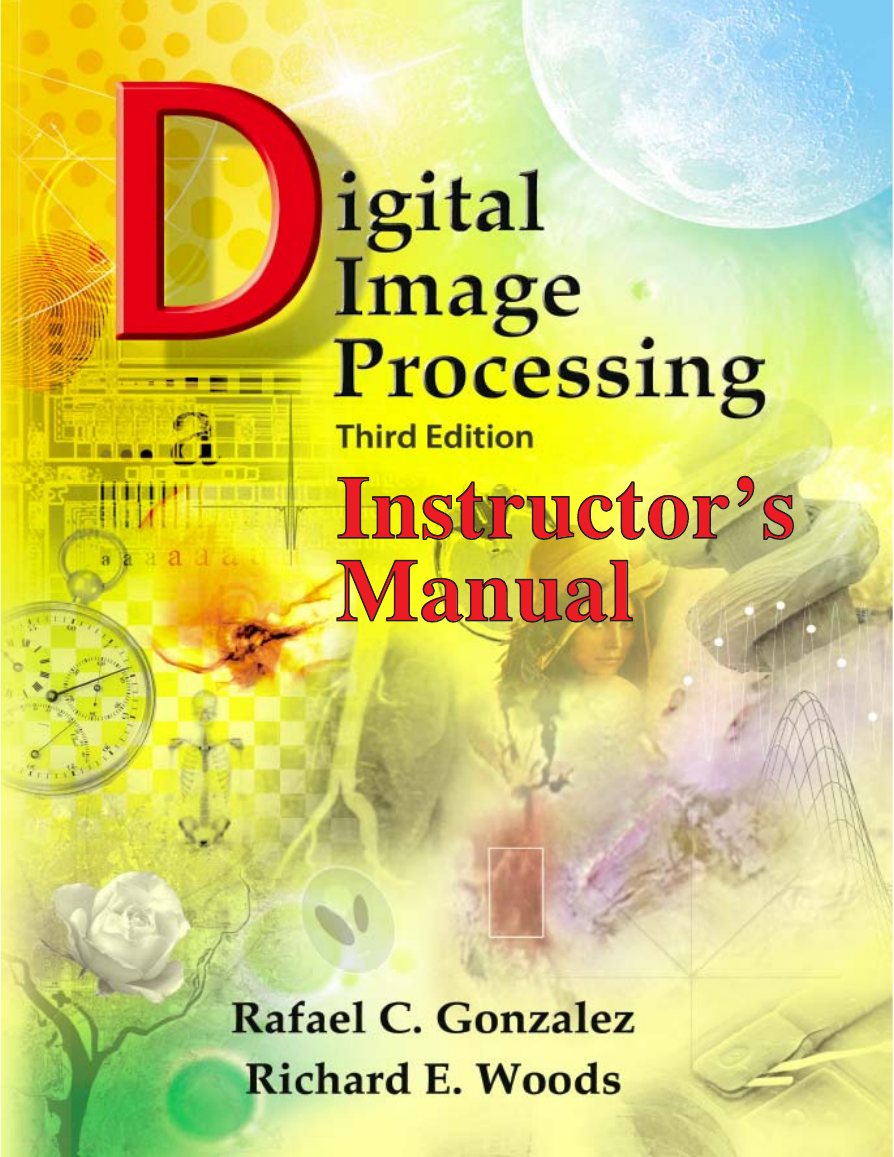

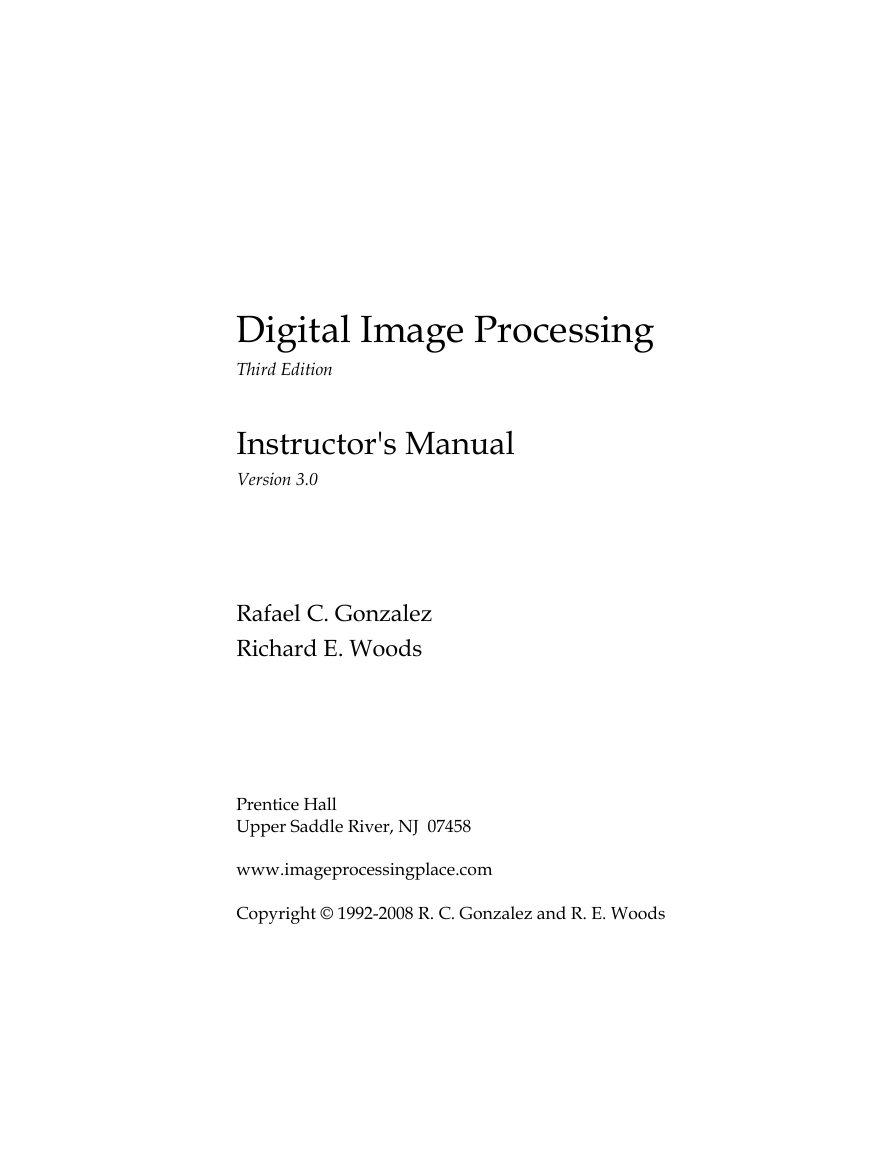

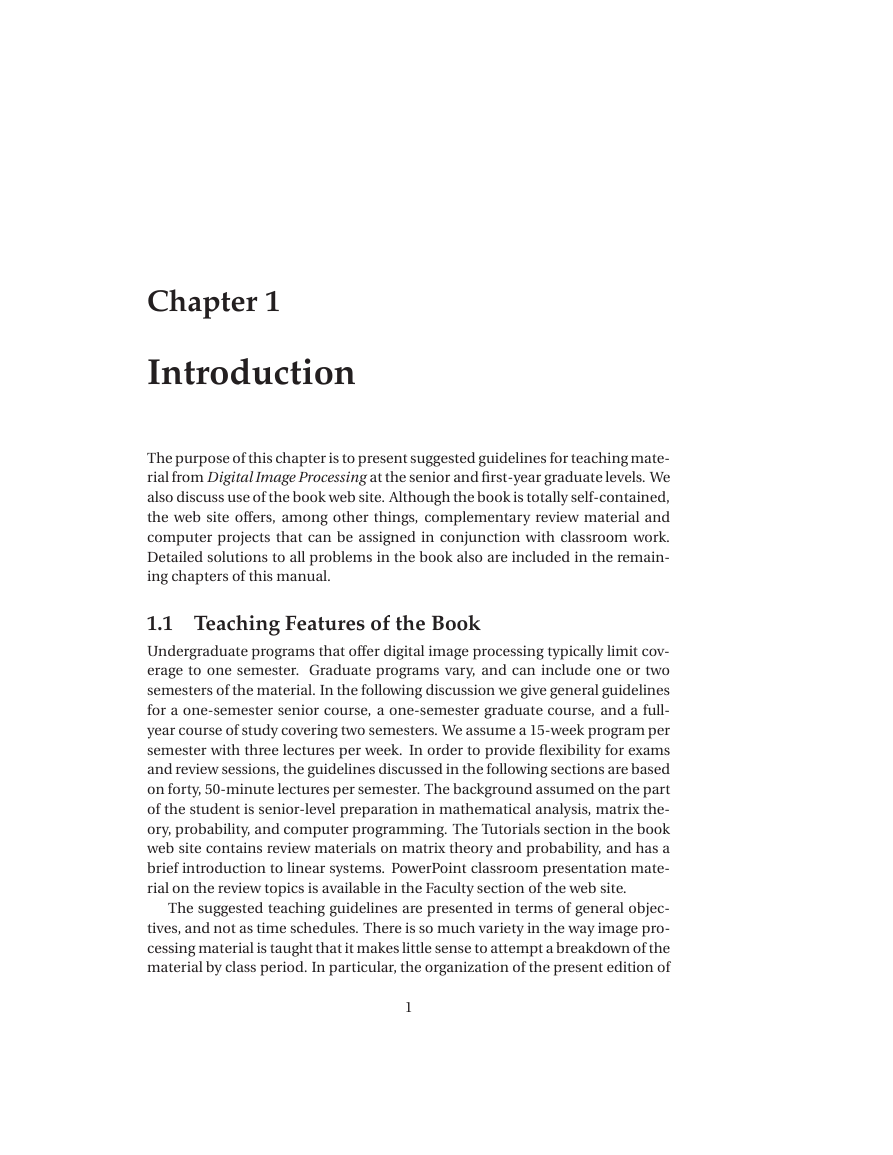
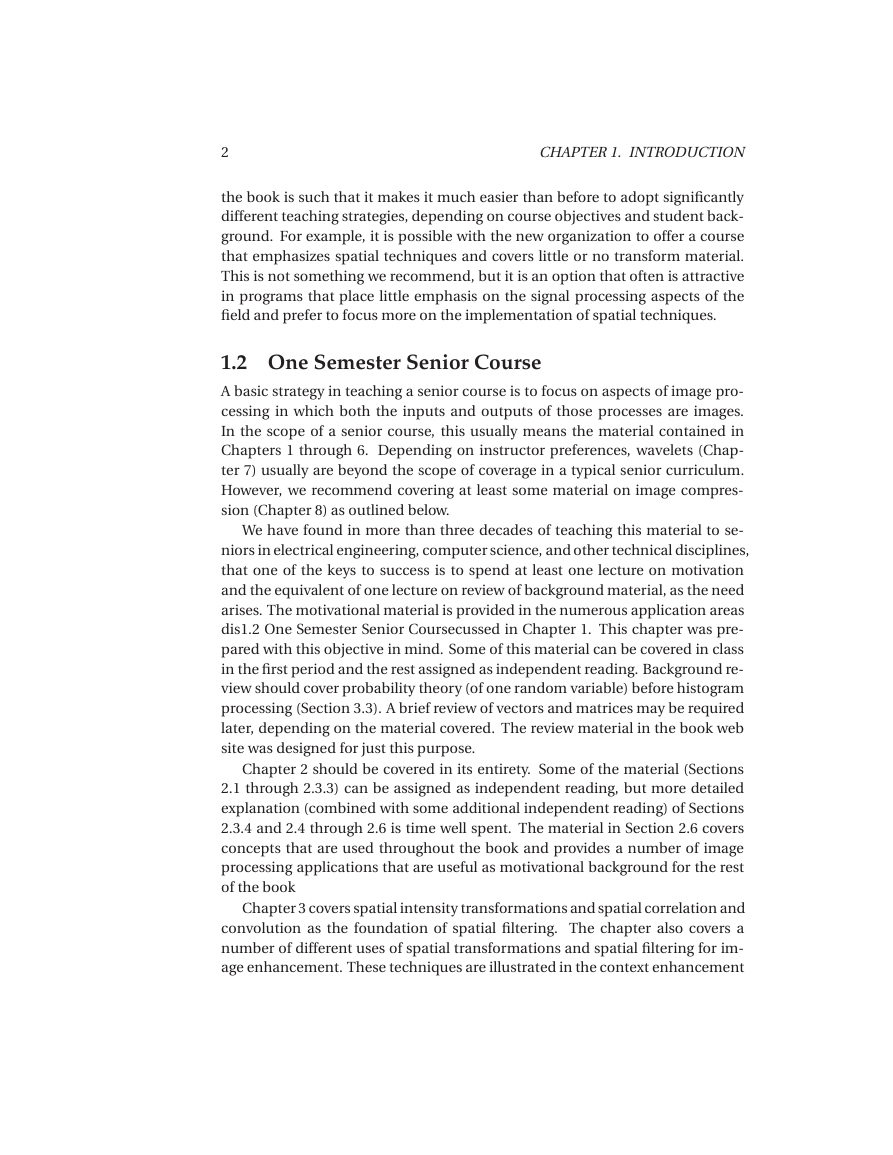
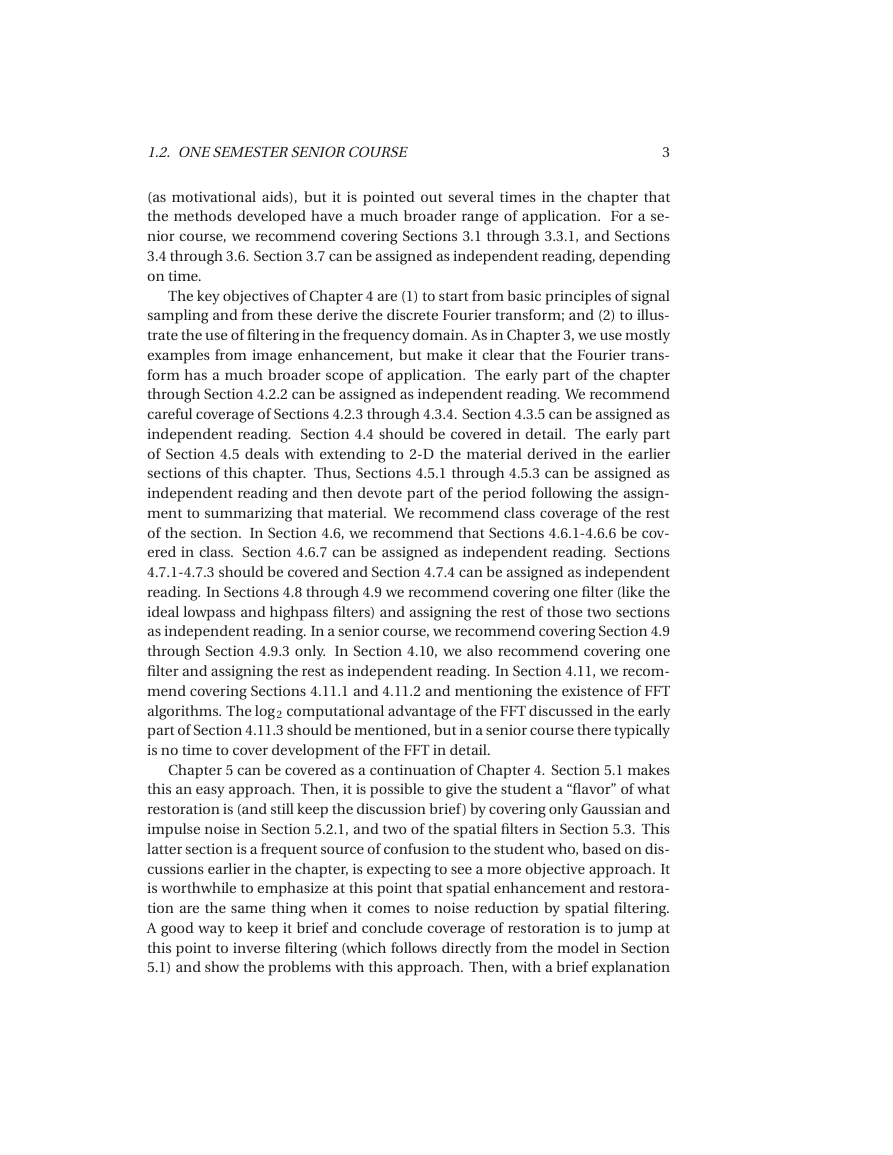
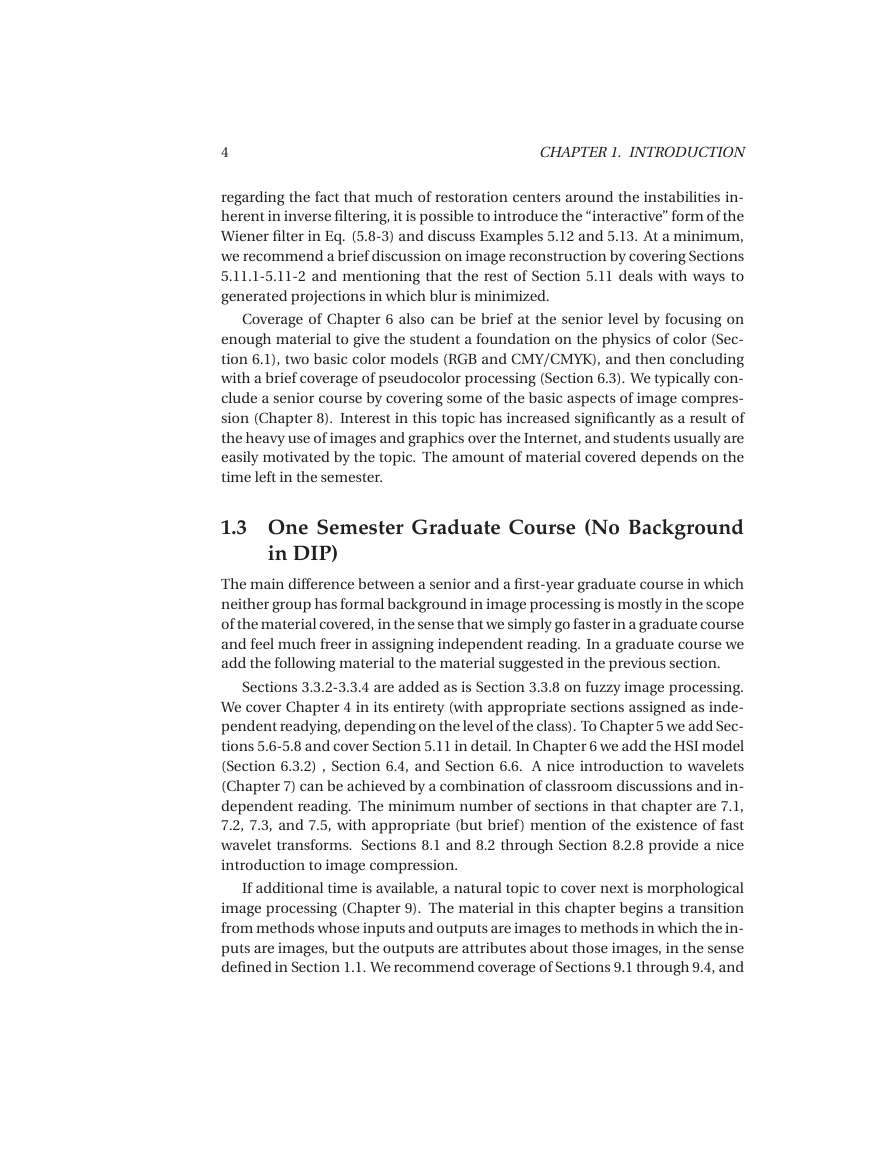








 2023年江西萍乡中考道德与法治真题及答案.doc
2023年江西萍乡中考道德与法治真题及答案.doc 2012年重庆南川中考生物真题及答案.doc
2012年重庆南川中考生物真题及答案.doc 2013年江西师范大学地理学综合及文艺理论基础考研真题.doc
2013年江西师范大学地理学综合及文艺理论基础考研真题.doc 2020年四川甘孜小升初语文真题及答案I卷.doc
2020年四川甘孜小升初语文真题及答案I卷.doc 2020年注册岩土工程师专业基础考试真题及答案.doc
2020年注册岩土工程师专业基础考试真题及答案.doc 2023-2024学年福建省厦门市九年级上学期数学月考试题及答案.doc
2023-2024学年福建省厦门市九年级上学期数学月考试题及答案.doc 2021-2022学年辽宁省沈阳市大东区九年级上学期语文期末试题及答案.doc
2021-2022学年辽宁省沈阳市大东区九年级上学期语文期末试题及答案.doc 2022-2023学年北京东城区初三第一学期物理期末试卷及答案.doc
2022-2023学年北京东城区初三第一学期物理期末试卷及答案.doc 2018上半年江西教师资格初中地理学科知识与教学能力真题及答案.doc
2018上半年江西教师资格初中地理学科知识与教学能力真题及答案.doc 2012年河北国家公务员申论考试真题及答案-省级.doc
2012年河北国家公务员申论考试真题及答案-省级.doc 2020-2021学年江苏省扬州市江都区邵樊片九年级上学期数学第一次质量检测试题及答案.doc
2020-2021学年江苏省扬州市江都区邵樊片九年级上学期数学第一次质量检测试题及答案.doc 2022下半年黑龙江教师资格证中学综合素质真题及答案.doc
2022下半年黑龙江教师资格证中学综合素质真题及答案.doc